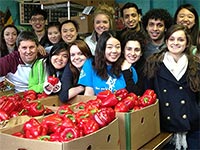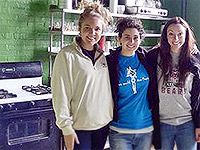 Rather than journey to warmer climates to spend a few days in the sun during spring break 2013, 15 students from Missouri State University (MSU), roughly half from the United States and half international students from other countries, packed into two vans and rode eight hours to Chicago for a week of volunteer service. MSU's Alternative Spring Break (ASB) trip taught the participating students many lessons about the world around them and also about each other.
Rather than journey to warmer climates to spend a few days in the sun during spring break 2013, 15 students from Missouri State University (MSU), roughly half from the United States and half international students from other countries, packed into two vans and rode eight hours to Chicago for a week of volunteer service. MSU's Alternative Spring Break (ASB) trip taught the participating students many lessons about the world around them and also about each other.
This year's trip, in early March, marked the second year that MSU organized the trip, and Darren Young, a technical support specialist for international programs, served as a staff adviser on both trips. Part of Young's job at the university is to foster interaction between domestic and international students, and he thinks that the Chicago trip is one of the best ways to do this.
"I tell students, "Don't be surprised if you become really good friends." [Students from the first trip] will have reunions every so often. They'll have dinners, too," he said. "Everyone was from different backgrounds and different majors, but we became a unit, working together." The key, said Young, is to remove students from their typical surroundings. "We could do this in our own community, but when we are out of that comfort zone, when we are working in an atmosphere that is neutral, they are able to view things in a different light." The eight-hour van ride also played a crucial part in breaking the ice. "We mix them up, make them switch vans and get to know each other."
 The most recent trip combined four days of service at shelters and food pantries with a few days of site seeing in Chicago. Students did everything from prepare toiletry bags to stock food pantry shelves to serve meals and talk with homeless people.
The most recent trip combined four days of service at shelters and food pantries with a few days of site seeing in Chicago. Students did everything from prepare toiletry bags to stock food pantry shelves to serve meals and talk with homeless people.
"It adds up to 19 hours of service per person," said Kristina Moller, one of group's student leaders. "Every day we have dinner together and then a reflection period to talk about what we experienced together."
In these reflection periods, student shared insights on similarities and differences related to poverty, homelessness, and hunger in their own countries. Yen Nguyen, an international student from Vietnam, told the group that she "really respected the American [social] services because they were organized," whereas in Vietnam, social services do not have the same support and resources.
In those discussions, students gained new perspectives and learned more about each other. "It's a great opportunity to learn about different cultures, and even though it's an American community that we are helping, it's great to learn ways we can help other countries in the future," said Garrett Mueller, the other student leader in the group.
"One of the nice things about the trip," added Dr. James Baker, MSU's vice president for research and economic development and international programs, "is that it fits into the context of our university. It's part of our public affairs mission, which involves ethical leadership, community engagement, and cultural competence, and it's part of the fabric of what we do."
Charline Da Costa, an international student from France and president of an international student group at MSU, noted, "It was like we weren't international students. We were all working together for the same goals. One group, one people."
 For Moller, one of the best moments of the trip happened on the first day of volunteering. A staff member at the food pantry was briefing the group and gave them some advice on how to approach the week. "He said, ‘We can't change the homeless people; we can only change the way we look at them.'"
For Moller, one of the best moments of the trip happened on the first day of volunteering. A staff member at the food pantry was briefing the group and gave them some advice on how to approach the week. "He said, ‘We can't change the homeless people; we can only change the way we look at them.'"
An apt thought for students not only working with less fortunate people but also learning that their peers from around the world are not as different as they seem.
Read the students' trip blog to learn more about the experience in their own words, and watch a video recap of MSU's first service trip to Chicago in 2012.
What program at your university excels at uniting international and domestic students?
